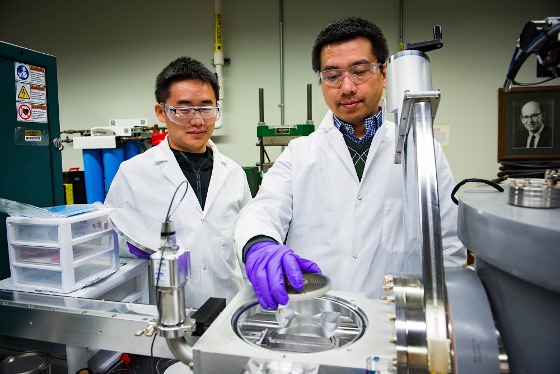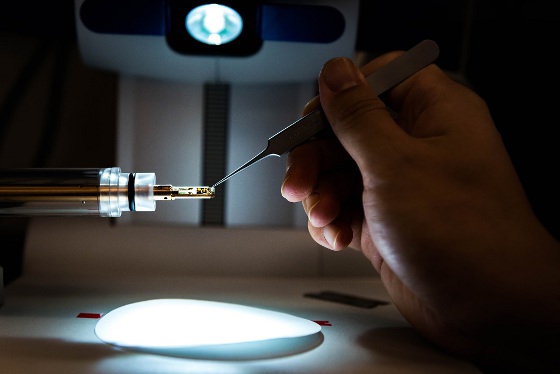 |
| January 15, 2019 | Volume 15 Issue 02 |
Designfax weekly eMagazine
Archives
Partners
Manufacturing Center
Product Spotlight
Modern Applications News
Metalworking Ideas For
Today's Job Shops
Tooling and Production
Strategies for large
metalworking plants
New research yields super-strong aluminum alloy

Purdue postdoctoral research associate Sichuang Xue, at left, and doctoral student Qiang Li prepare a sample for research to create super-strong aluminum alloys. [Purdue University image/Marshall Farthing]
Researchers have demonstrated how to create a super-strong aluminum alloy that rivals the strength of stainless steel, an advance with potential industrial applications.
"Most lightweight aluminum alloys are soft and have inherently low mechanical strength, which hinders more widespread industrial application," said Xinghang Zhang, a professor in Purdue University's School of Materials Engineering. "However, high-strength, lightweight aluminum alloys with strength comparable to stainless steels would revolutionize the automobile and aerospace industries."
New research shows how to alter the microstructure of aluminum to impart greater strength and ductility. Findings were detailed in two new research papers. The work was led by a team of researchers that included Purdue postdoctoral research associate Sichuang Xue and doctoral student Qiang Li.
The most recent paper was published online Jan. 22 in the journal Advanced Materials. The earlier paper was published in November in the journal Nature Communications.
The new high-strength aluminum is made possible by introducing "stacking faults," which are distortions in the crystal structure. While these are easy to produce in metals such as copper and silver, they are difficult to introduce in aluminum because of its high "stacking fault energy."
VIDEO: Purdue Engineering -- How to create a super-strong aluminum alloy.
A metal's crystal lattice is made up of a repeating sequence of atomic layers. If one layer is missing, there is said to be a stacking fault. Meanwhile, so-called "twin boundaries" consisting of two layers of stacking faults can form. One type of stacking fault, called a 9R phase, is particularly promising, Zhang said.
"It has been shown that twin boundaries are difficult to be introduced into aluminum. The formation of the 9R phase in aluminum is even more difficult because of its high stacking fault energy," Zhang said. "You want to introduce both nanotwins and 9R phase in nanograined aluminum to increase strength and ductility and improve thermal stability."
Now, researchers have learned how to readily achieve this 9R phase and nanotwins in aluminum.
"These results show how to fabricate aluminum alloys that are comparable to, or even stronger than, stainless steels," he said. "There is a lot of potential commercial impact in this finding."
Xue is lead author of the Nature Communications paper, which is the first to report a "shock-induced" 9R phase in aluminum. Researchers bombarded ultrathin aluminum films with tiny micro-projectiles of silicon dioxide, yielding 9R phase.
"Here, by using a laser-induced projectile impact testing technique, we discover a deformation-induced 9R phase with tens of nanometers in width," Xue said.

A sample is readied for analysis using a transmission electron microscope. [Purdue University image/Marshall Farthing]
The microprojectile tests were performed by a research group at Rice University, led by professor Edwin L. Thomas, a co-author of the Nature Communications paper. A laser beam causes the particles to be ejected at a velocity of 600 meters per second. The procedure dramatically accelerates screening tests of various alloys for impact-resistance applications.
"Say I want to screen many materials within a short time," Zhang said. "This method allows us to do that at far lower cost than otherwise possible."
Li is lead author of the Advanced Materials paper, which describes how to induce a 9R phase in aluminum not by shock but by introducing iron atoms into aluminum's crystal structure via a procedure called magnetron sputtering. Iron also can be introduced into aluminum using other techniques, such as casting, and the new finding could potentially be scaled up for industrial applications.
The resulting "nanotwinned" aluminum-iron alloy coatings proved to be one of the strongest aluminum alloys ever created, comparable to high-strength steels.
"Molecular-dynamics simulations, performed by professor Jian Wang's group at the University of Nebraska, Lincoln, showed the 9R phase and nanograins result in high strength and work-hardening ability and revealed the formation mechanisms of the 9R phase in aluminum," Zhang said. "Understanding new deformation mechanisms will help us design new high-strength, ductile metallic materials, such as aluminum alloys."
Source: Purdue University
Published February 2018
Rate this article
View our terms of use and privacy policy
